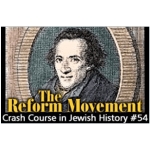History Crash Course #54: The Reform Movement
Author’s note: This section on the Reform Movement (and part 58) is meant as an overview of the origins and history of the movement. It is not meant to reflect the modern attitude of the Reform Movement nor its present-day adherents.
Nearly 200 years after the founding of the first Reform congregations, the movement has gone through a significant metamorphosis. The failure of an enlightened Europe to end anti-Semitism; the Holocaust; the birth of the State of Israel and the high rate of intermarriage and assimilation among successive generations of Reform Jews has led to what can only be termed a dramatic about face in the Reform attitude toward both Jewish observance and Jewish national identity. These monumental changes are best reflected in The Statement of Principles for the Reform Judaism adopted by the CCAR (Central Conference of American Rabbis) May 1999. President Rabbi Richard Levy called for an increased commitment to observance, Torah study and Israel, a radical departure from previous CCAR platforms.
While the ideological differences between Orthodox and Reform remain enormous, these changes clearly reflect the modern Reforms Movement’s recognition of what has shown to be a historically proven reality: What has kept Jews Jewish for thousands of years is a commitment to Judaism ― its study, observance, and the primacy of Judaism as a central component of every Jew’s identity.
As we saw in the last installment, the Enlightenment gave Jews new rights ― human rights and citizenship rights ― which they never had before. After centuries of physical and economic marginalization, the intoxicating allure of emancipation proved overwhelming attractive to many Jews in Western Europe. Many desired nothing more than to prove to their loyalty to their host country and the best way to do this was to join the army, which for centuries had been closed to Jews. In Prussia and later Germany, disproportionately large numbers of Jews volunteered for military service. To quote a David Friedlander, a Jewish volunteer in the Prussian army during the Napoleonic wars:
…[it was] a heavenly feeling to possess a fatherland! What rapture to be able to call a spot, a place, a nook one’s own upon this lovely earth….Hand in hand with your fellow soldiers you will complete the great task; they will not deny the title of brother for you will have earned it.”[1]Amos Elon, The Pity of It All ― A Portrait of the German-Jewish Epoch 1743-1933, ( New York, 2002), p. 95. World War I is a great example: 120,000 Jews served in the German army and 12,000 died in … Continue reading
The new broad-mindedness went so far that Jews were even accepted into society as long as they were not “too Jewish” ― as long as they didn’t dress too differently, behave too differently, eat a different diet, or insist on wearing their “old-fashioned” religion on their sleeve.
The reaction to this from some Jews was a staunch refusal to cooperate and get with the plan ― in any way, shape or form.
But there was also the opposite reaction from others. These Jews went along with the spirit of liberation and modernity and dropped the things that had made them different from other people ― such as keeping kosher, keeping Shabbat, etc.
Of course, as soon as Jews drop their religion, they begin to assimilate. Intermarriage rates climbed dramatically. In Germany, for example they rose from 8.4 percent in 1901 to 30 percent by 1915.[2]The Pity of It All, p. 225. Marginal Jewish identity and assimilation became the norm during the 19th century While we don’t have exact figures for the rate of assimilation, what we do know is that an estimated quarter of a million Jews converted to Christianity during this time and that countless others assimilated into the European culture.
Interestingly, the assimilation rate was higher where there were fewer Jews. In Eastern Europe, where the Jewish population was almost 5 million, 90,000 (or not quite 2%) converted to Christianity in order to have an easier life and mingle with mainstream society. But in Western Europe where there were fewer Jews, the proportions were much higher. The majority of the Jews of France assimilated, as did the majority of the Jews of Italy and Germany.
Why? Because in Western Europe, the governments were more liberal and open, Jews were granted citizenship and the non-Jews were generally less hostile so the attraction to assimilate and join the mainstream was much greater.
Some Jewish converts to Christianity were very famous. In Part 53, we already mentioned Benjamin Disraeli, the British Prime Minister who became the great architect of Victorian imperialism. But we must also mention Karl Marx, the father of Communism.
Marx was converted by his father at age six; the father himself had converted a few years earlier in order to be able to practice law. Marx, who eventually became an atheist, is the author of The Communist Manifesto and Das Kapital, ironically called the “Bible of the Worker.” He is also famous for calling religion “the opiate of the masses.”
A terrible example of a self-hating Jew, Marx blamed all the world problems on the Jews in his rage-filled A World without Jews. Virulent hatred of Judaism and other Jews was not uncommon to such converts. It infected, among others, Heinrich Heine, one of the greatest figures in 19th century German literature.
Heine converted, as did so many, for pragmatic reasons, explaining his conversion: “From the nature of my thinking you can determine that baptism is a matter of indifference to me and I do not regard it as important even symbolically. My becoming a Christian is the ticket of admission to European culture.”[3]The Jew in the Modern World by Paul Mendes-Flohr and Jehuda Reinharz, pp. 258-259. He was as cynical about Judaism, declaring it one of the world’s three greatest evils (along with poverty and pain.)
German Reform
One of the more dramatic reactions to the changes of this time period came from a group of German Jews who formed what came to be known as the “Reform Movement.”
The German Jews who began the Reform Movement in the early 1800s wanted to maintain some kind of connection to Judaism, but at the same time wanted to take advantage of the newly-won rights and freedoms, which were available only if one became a full-fledged member of European society. Traditional Jewish lifestyle (kashrut and shabbat observance etc.) and national identity were viewed as barriers to this acculturation: So these German Jews set about dropping some key aspects of traditional Judaism. The most dramatic of these was the belief that the Torah was given to Jews by God at Mount Sinai.
For 3,000 years Jews never questioned that the Torah came from God. The various sects that developed ― such as the Sadducees and the Karaites ― questioned the oral tradition or rabbinic law, but never the Divine origin of the Torah. This was an earth-shattering precedent.
The first crack in the dam came from Moses Mendelssohn (1729-1786), a brilliant intellect who was known as the “hunchback philosopher.” Although an observant Jew in terms of his lifestyle, he advocated the “rational” approach to religion, as he wrote in his Judaism as Revealed Legislation:
“Religious doctrines and propositions … are not forced upon the faith of a nation under the threat of eternal or temporal punishment but in accordance with the nature and evidence of eternal truths recommended to rational acknowledgment. The Supreme Being has revealed them to all rational creatures.”
In effect, Mendelssohn was following the pattern of the thinkers of the Enlightenment, the “Age of Reason.” Religion should be rational. If the law of God seems irrational, then man must follow reason. (Mendelssohn’s children were not observant and within a few generations they had either assimilated or converted. Mendelssohn’s grandson, the famous German composer Felix Mendelssohn-Bartholdy, was baptized as a child by his assimilated parents.)
By opening up Judaism to this kind of rational skepticism, Mendelssohn opened the door through which others rushed in.
This is not to suggest that before him Judaism was closed to inquiry. Indeed, asking questions was always a big part of Judaism, but it was was grounded in certain beliefs and assumptions, which in the Reform Movement came tumbling down.
The first Reform service was conducted by Israel Jacobson in his school chapel in Seesen, Germany in 1810, and it was adopted by the first Reform synagogue which opened in Hamburg in 1818.
The Reform service had a choir, robes, and an organ; it was conducted in German with German songs and German prayers in a deliberate attempt to emphasize nationalistic loyalty and identity and to make synagogue worship resemble as much as possible to the mainstream German Protestant service.
The New Israelite Temple Association-Hamburg Dec. 1817:
…the worship service shall be conducted on Sabbath and holy days….Specifically, there shall be introduced at such services a German sermon, and choral singing to the accompaniment of a organ….it shall apply to all those religious customs…which are sanctified by the church.[4]Paul Mendes-Flohr & Yehuda Reinharz ed., The Jew in the Modern World ― A Documentary History, (Oxford University Press, 1995), p. 161.
Jewishly, however, this was quite a departure. Up until then, Jews prayed in Hebrew, reciting the prayers composed by the Men of the Great Assembly and by the Sanhedrin some two thousand years earlier. Jews never played musical instruments during Shabbat services, and certainly not an organ which was an instrument common to Christian churches, as was the choir and the robes.
Not long after, the Reform Movement switched Shabbat from Jewish Saturday to Christian Sunday, and came to call its synagogues “temples” to underscore the point that Reform Jews no longer looked to the rebuilding of “The Temple” in Jerusalem.
In fact, Reform leader Samuel Holdheim (1806-1860), who became the head of the Reform congregation in Berlin, argued against the mention of Jerusalem, Zion, or the land of Israel during services. He opposed circumcision, wearing of skull caps or prayer shawls, or the blowing of the shofar ― in short just about anything traditionally Jewish.
Another Reform leader Abraham Geiger (1810-1874), who led reform groups in Breslau, Frankfurt and Berlin, called circumcision “a barbaric act of blood-letting rite” and advocated against “the automatic assumption of solidarity with Jews everywhere.”
These were big breaks with tradition. Ever since Abraham, circumcision was the way Jews marked their covenant with God. And Jews helping each other in times of trouble ― one for all and all for one ― was seen as an integral part of Jewish nature as defined by God (see Part 14).
Reformers of Germany declared that they were not members of the nation of Israel but “Germans of the Mosaic persuasion.”
The philosophy of the German Reform Movement evolved further at conferences held in Brunswick in 1844 and in Frankfurt in 1845. Here are excerpts that show how much the Jews of Germany wanted to show their allegiance to their country of residence, which meant disavowing any allegiance to the Land of Israel or the Hebrew language:
Reform Rabbinic Conference-Brunswick 1844:For Judaism, the principal of human dignity is cosmopolitan, but I would like to put proper emphasis on the love of the particular people [among whom we live] and its individual members. As men, we love all mankind, but as Germans, we love the Germans as the children of the fatherland. We are, and ought to be patriots, not merely cosmopolitan.[5]The Jew in the Modern World, pp. 183-185.
Reform Rabbinic Conference-Frankfurt-1845:
By considering Hebrew as being of central importance to Judaism, moreover, one would define it as a national religion. Because a separate language is a characteristic element of a separate nation. But no member of this conference, the speaker concluded, would wish to link Judaism to a particular nation.
The hope for national restoration contradicts our feelings for the fatherland…The wish to return to Palestine in order to create there a political empire is superfluous…But Messianic hope, truly understood is religious…This later religious hope can be renounced only by those who have a more sublime conception of Judaism, and who believe that the fulfillment of Judaism’s mission is not dependent on the establishment of a Jewish state, but rather by the merging of Jewry into the political constellation of the fatherland. Only an enlightened conception of religion can replace a dull one….This is the difference between strict Orthodoxy and Reform: Both approach Judaism from a religious standpoint: but while the former [Orthodox] aims at restoration of the old political order, the later [Reform] aims at the closest possible union with the political and national union of out times…[6]Ibid., pp.178-185.
(For more on this subject, see History of the Jews by Paul Johnson, pp. 333-335, and Triumph of Survival by Berel Wein pp. 52-53, and The Jew in the Modern World ed. by Paul Medes-Flohr and Jehuda Reinharz pp. 161-177.)
The Orthodox
Along the way, the members of Reform Movement coined a new term to describe those who stuck to traditional Judaism ― they called them the “Orthodox” which implied of course that observant Jews were backward-a relic of the past, as opposed to “Reform” who were forward thinking, modern and progressive.
In places where the Reform Movement succeeded in attracting the majority of Jews, it did its best to force its agenda on the minority. In Frankfurt, for example, the mikvah (the ritual pool) was closed, kosher slaughter was banned, the teaching of Torah was forbidden. The Orthodox Jews were basically run out of town. In Frankfurt am Main, one of the oldest Jewish communities in Europe, only about one hundred observant families remained by the middle of the 19th century.
Why?
The German Reformers were afraid that while they might be able to assimilate into the larger German culture, as long as there continued to exist a group of Jews who chose to act as Jews and openly identify as such ― that is, Jews who irked the Germans ― then the Germans would lump everyone together and continue to be hostile toward them as well.[7]One could also make a psychological argument that on a subconscious level the continued presence of observant Jews in the community would serve as a constant painful reminder that these non-observant … Continue reading
But of course the Jews who would not go along with the Reform Movement weren’t about to take all this sitting down.
The leader of the Orthodox counter-attack against the Reform Movement was a rabbi by the name of Samson Raphael Hirsch (1808 to 1888). Hirsch was born in Hamburg and after completing his rabbinic studies he attended the University of Bonn. He served as a Rabbi in several communities and as the chief rabbi of Moravia, a community of 50,000 Jews. He published several well-known works such as Horeb in which he sought to demonstrate the viability of traditional Judaism in the modern world.
In 1851 he moved to Frankfurt am Main, to serve as Rabbi of the shrinking community and wage the philosophical counteroffensive to the Reform movement.
As part of his fight he succeeded in setting up his own Orthodox institution in Frankfurt which is called the Kahal Adas Yeshurin, and he created his own religious school system.
His aim was to show those Jews who wanted to be modern that it was possible ― all within the context of traditional Judaism. There is no need to drop Torah in order to get along in an evolving world as the Torah makes provisions for all that. This is what he wrote in 1854 in an article entitled, “Religion Allied to Progress” (see Collected Writings of Samson Raphael Hirsh):
“Now what is it that we want? Are the only alternatives either to abandon religion or to renounce all progress? We declare before heaven and earth that if our religion demanded that we should renounce what is called civilization and progress we would obey unquestioningly, because our religion is for us the word of God before which every other consideration has to give way. There is, however, no such dilemma. Judaism never remained aloof from true civilization and progress. In almost every area its adherents were fully abreast of contemporary learning and very often excelled their contemporaries. An excellent thing is the study of Torah combined with the ways of the world.”[8]Ibid., pp. 197-202.
What Rabbi Hirsch emphasized was that the normal Jewish way to be is to be fully in the world but also to be fully immersed in Torah. It is not a question of “either Torah or the World” ― it’s a question of priorities. He made it very clear that the first priority is Torah. In contrast to Mendelssohn, he said that even if you didn’t understand some part of the Torah, you had to follow it anyway because it is the word of God.
(For more on this subject see Rabbi Samson Raphael Hirsch: Architect of Torah Judaism for the Modern World by Elijahu Meir Klugman.)
Despite the efforts of Rabbi Samson Raphael Hirsch and others, the Reform Movement spread, not just inside Germany but to other countries as well, though each group of Reformers had its own take on it. For example, the Reform Jews of England in the West London Synagogue adopted a quasi-Karaite position. They stuck to the Torah as the word of God, but rejected the teachings of the Talmud.
In America, the Reform Movement also took on its special character after it was transplanted there from Germany by several hundred thousand German immigrants in the mid-19th century. We will take a look at it when we take up the Jewish life in America.
References
| ↑1 | Amos Elon, The Pity of It All ― A Portrait of the German-Jewish Epoch 1743-1933, ( New York, 2002), p. 95. World War I is a great example: 120,000 Jews served in the German army and 12,000 died in the war. Hitler even received his Iron Cross from Jewish commanding officer. |
|---|---|
| ↑2 | The Pity of It All, p. 225. |
| ↑3 | The Jew in the Modern World by Paul Mendes-Flohr and Jehuda Reinharz, pp. 258-259. |
| ↑4 | Paul Mendes-Flohr & Yehuda Reinharz ed., The Jew in the Modern World ― A Documentary History, (Oxford University Press, 1995), p. 161. |
| ↑5 | The Jew in the Modern World, pp. 183-185. |
| ↑6 | Ibid., pp.178-185. |
| ↑7 | One could also make a psychological argument that on a subconscious level the continued presence of observant Jews in the community would serve as a constant painful reminder that these non-observant Jews had rejected their heritage and strayed from the path. |
| ↑8 | Ibid., pp. 197-202. |











Eccellent explanation of a painful phenomenon; they drill holes in the hull and we are soaked to our necks, but are not reacting. They got as far as the Knesset last time, but now their parties are gone on a long cruise.It’s Aliyah time, see https://mediartlab.com